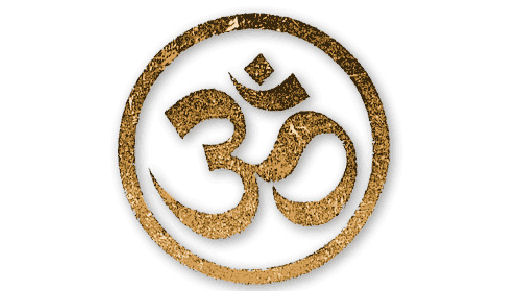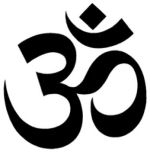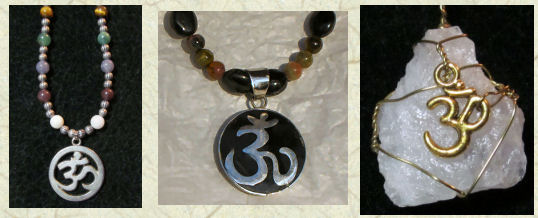Om (Aum)

What is Om?
You are probably familiar with the Om sound and sacred chant, if not the symbol that represents it. Om is often spoken at the beginning and sometimes the end of many Hindu mantras, prayers, and meditations. Do you know Om Mane Padme Hum, the mantra used most often by Buddhists and in the practice of Yoga?
Om mystically embodies the essence of the entire universe. It has been called “the mother of all mantras” – a holy meditation symbol of Hinduism, Buddhism, and Jainism with a profusion of esoteric and exoteric meanings.
Om, both a sound and a symbol, is comprised of three distinct Sanskrit sounds – A-U-M, so Om is also spelled Aum (the vowels A and U combine in Sanskrit to become O). These three sounds illustrate the symbol’s threefold nature.
Om Represents:
- the three worlds: earth, atmosphere, and heaven
- the three major Hindu gods: Brahma- the creator, Visnu – the Maintainer, and Siva – the Destroyer of the universe.
- the three sacred Vedic scriptures: Rg, Yajur, and Sama
- the three states of consciousness: Vaishvanara, Taijasa, and Prajna
- the three dimensions: length, breadth and depth
– with the entire symbol representing the perfect man, one whose wisdom is firmly established in the divine - the three genders: masculine, feminine, and neuter
– with the entire symbol representing the Creator, who transcends the limitations of time - the three tenses: past, present and future
– with the entire symbol representing the Creator, who transcends the limitations of time - the teaching imparted by the mother, the father, and the Guru respectively
– with the entire symbol representing Brahma Vidya, the knowledge of the Sel and, the teaching which is imperishable - the living spirit (a portion of the divine spirit): speech (vak), the mind (manas), and the breath of life (prana)
How does the symbol represent Om?

The Om (AUM) symbol consists of three curves, one semicircle, and a dot. With its threefold nature, special shape and unique sound, Om lends itself to a variety of detailed symbolic interpretations.
These four parts symbolize four stages of consciousness: awake, sleeping, dreaming, and a trance or transcendental state.
The Bottom Left Curve: The A That Begins the O Sound
The large lower curve on the left symbolizes the waking state and the moving mind. The larger size signifies that this is the most common state of the human consciousness and stands for the entire physical world of experience. When you are awake, you are aware of your physical body and this physical world. The open shape of the curve and its tapered form indicates that it’s hard for us to know, when the mind is moving, where the permanence of true self ends and where the impermanence of worldly things begins.
The Right Curve: The U That Finishes the O Sound
The middle curve on the right represents the dream state, also known as the thought world, which is distinctly experienced as other than the physical world. In this state the consciousness of the individual is turned inwards, as the dreaming self beholds an enthralling view of the world behind the lids of the eyes.
Top Left Curve: The M Sound
The upper, top left curve denotes the state of deep, dreamless sleep or the unconsciousness,. In this state the sleeper desires nothing nor beholds any dream. This open curve does not taper so that there is a clear line between what is inner, formless self, and finite, changing, external and manifest non-self. The curve is open to experience, but it knows where true self ends and ego-self begins. That clarity makes visible the meaning of the dot at the top of the symbol.
These three curves, the three states of an individual’s consciousness, represent the entire physical phenomenon. The sleeper and the sleep experience, the dreamer and the dream experience and the waker and the waking experience constitute what we call everything that is here. All these three together represent ‘Om’. Om is complete.
The Dot: The Silence After the Sound
At the end of AUM is a pause, represented in the symbol by the dot. This is the fourth state, Infinite Consciousness, that infinite non-thing that spiritual aspirants seek. In this state the consciousness looks neither outwards nor inwards, nor the two together. It signifies the coming to rest of all differentiated, relative existence. This utterly quiet, peaceful and blissful state is the ultimate aim of all spiritual activity.
The Horizontal Curve: The Two-Way Mirror
The semi-circle at the top represents Maya and separates the dot from the other three curves. This horizontal curve is like a two-way mirror. It represents the illusory way that living among things prevents us from seeing the deepest reality. When we look outside for the infinite, we only see our ego self-reflected back at us. Note that this curve tapers where it separates the top dot (representing the infinite) from the previous curve (representing non-attachment to experience).
Gallery Samples

